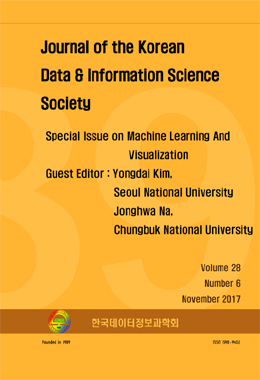최근 여러 분야에서 데이터에 근거한 분석방법론에 대한 수요가 증대됨에 따라 이를 처리할 수 있는 최적화 방법이 발전되고 있다. 특히 통계학과 기계학습 분야의 문제들에서 요구되는 다양한 제약 조건은 볼록 최적화 (convex optimization) 방법으로 해결할 수 있다. 본 논문에서 리뷰하는 alternating direction method of multipliers (ADMM) 알고리즘은 선형 제약 조건을 효과적으로 처지 할 수 있으며, 합의 방식을 통해 병렬연산을 수행할 수 있어서 범용적인 표준 최적화 툴로 자리매김 되고 있다. ADMM은 원래의 문제보다 최적화가 쉬운 부분문제로 분할하고 이를 취합함으로써 복잡한 원 문제를 해결하는 방식의 근사알고리즘이다. 부드럽지 않거나 복합적인 (composite) 목적 함수를 최적화할 때 유용하며, 쌍대이론과 proximal 작용소 이론을 토대로 체계적으로 알고리즘을 구성할 수 있기 때문에 통계 및 기계학습 분야에서 폭 넓게 활용되고 있다. 본 논문에서는 최근 통계와 관련된 여러 분야에서 ADMM알고리즘의 활용도를 살펴보고자 하며 주요한 두 가지 주제에 중점을 두고자 한다. (1) 목적식의 분할 전략과 증강 라그랑지안 방법 및 쌍대문제의 설명과 (2) proximal 작용소의 역할이다. 알고리즘이 적용된 사례로, 벌점화 함수 추정 등의 조정화 (regularization)를 활용한 방법론들을 소개한다. 모의 자료를 활용하여 lasso 문제의 최적화에 대한 실증결과를 제시한다.
In recent years, as demand for data-based analytical methodologies increases in various fields, optimization methods have been developed to handle them. In particular, various constraints required for problems in statistics and machine learning can be solved by convex optimization. Alternating direction method of multipliers (ADMM) can effectively deal with linear constraints, and it can be effectively used as a parallel optimization algorithm. ADMM is an approximation algorithm that solves complex original problems by dividing and combining the partial problems that are easier to optimize than original problems. It is useful for optimizing non-smooth or composite objective functions. It is widely used in statistical and machine learning because it can systematically construct algorithms based on dual theory and proximal operator. In this paper, we will examine applications of ADMM algorithm in various fields related to statistics, and focus on two major points: (1) splitting strategy of objective function, and (2) role of the proximal operator in explaining the Lagrangian method and its dual problem. In this case, we introduce methodologies that utilize regularization. Simulation results are presented to demonstrate effectiveness of the lasso.




